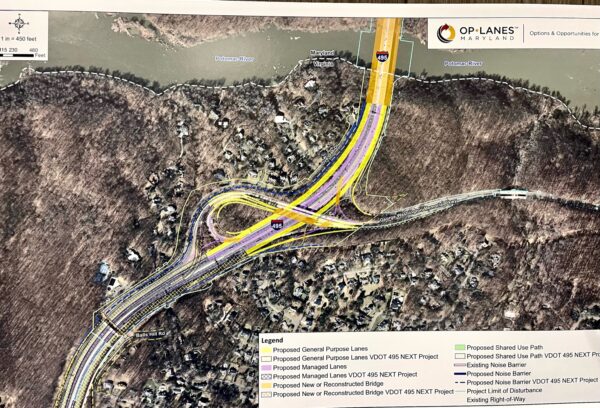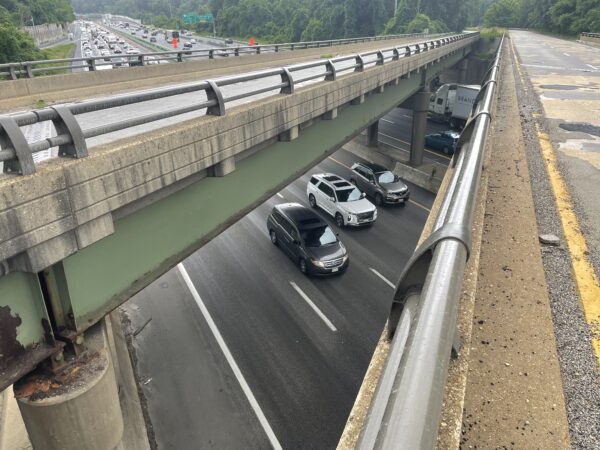MDOT’s Plan to Build Toll Lanes in Fairfax is an Unwelcome Surprise to Some Virginians

Maryland’s plans to undertake major construction work along the Capital Beltway in Fairfax County aren’t sitting well with some Northern Virginia residents and elected leaders, who are questioning why another state is involved in transportation projects outside its borders.
The critics say key details of the projects have only come to light recently — and they claim they have been stymied in their efforts to get officials with the Maryland Department of Transportation, the Virginia Department of Transportation and toll road operator Transurban to answer their questions in detail.
Officials from the two states held two town hall meetings last week — one at a high school in McLean, the other online. Although officials tried gamely to answer residents’ questions, many of the people who attended the sessions left feeling frustrated.
“Everybody is alarmed and everybody is pissed,” said Mei-Mei Venners, the owner of a McLean real estate firm, in an interview. “It’s got to do with expanding the [toll] lanes and trying to get this under the radar before somebody says stop.”
Transurban owns and operates more than 50 miles of variably-priced toll lanes throughout Northern Virginia and VDOT has expanded its existing contract with the firm to extend toll lanes closer to the American Legion Bridge, a project the agency calls 495NEXT.
Maryland’s proposed work in Fairfax County essentially picks up where 495Next ends, at a point south of the George Washington Memorial Parkway/I-495 interchange. If its plan is approved by the federal government, MDOT would build four variably-priced toll lanes in Virginia and it would completely re-do the Parkway/Beltway interchange — all as part of an ambitious proposal unveiled by Gov. Lawrence J. Hogan Jr. (R) in 2017.
The plan includes the reconstruction and widening of the American Legion Bridge. On Friday, federal and state officials are expected to release a Final Environmental Impact Statement on the first phase of Maryland’s plan, which would run from the GW Parkway to the I-270 split and then north to I-370.
Maryland has chosen Accelerate Maryland Partners, a consortium led by Transurban, to finance and perhaps construct its “managed” lanes. Virginia’s contract with Transurban dates back to 2007.
While it has generated numerous headlines on the Maryland side of the Potomac River, Fairfax residents said they were caught off-guard by news that Maryland will be adding toll lanes well into Northern Virginia.
“I’ve been totally tuned in to this thing for quite some time and I’ve just recently learned the essence of what they’re proposing to do,” said Fairfax Supervisor John Foust (D), who represents the area where the construction is slated to occur. “My constituents are very upset.”
Foust said Transurban has historically done considerable outreach to the community and its leaders, but this time it’s different. “It’s very difficult to get information from Maryland or Virginia about who is responsible for what,” he said.
“It is weird,” said Virginia state Sen. Barbara Favola (D) in an interview. Favola, who represents portions of Arlington, Fairfax, and Loudoun counties, attended last week’s town hall meetings. “We went away with a lot of unanswered questions, because to be honest, the Maryland involvement really just percolated up at [last week’s] meeting at Langley High School.”
Citizens who spoke at the meetings raised a host of objections. They expressed concerns that Maryland officials would not be responsive to their concerns about construction-related tie-ups, whether noise and visual blight will increase, the potential that headlights from cars on fly-over ramps will shine into people’s homes, and how traffic on arterial roads would be effected.
Susan Shaw, VDOT’s mega-projects director, said the two states and Transurban are coordinating closely to ensure the project is seamless. She said even if Maryland’s project fails to advance — Hogan leaves office in January and faces a tight timeline — the 495Next project works on its own.
“The project is coordinated. We have a number of scenarios under which the project could be delivered, so we just have to stay flexible with how that work might happen,” she told a town hall audience. “If it ends up that Maryland’s project doesn’t happen before our project is completed, our project is beneficial.” Shaw conceded that it is “complicated” to have two states doing major projects side-by-side at roughly the same time.
Frustrated residents said they had so many unanswered questions, mostly about whether MDOT would be accountable to communities in Fairfax, they requested that Favola, Foust (D) and state Del. Kathleen Murphy (D) submit a four-page list of questions to VDOT on their behalf. The list included a wide array of questions — 49 in all — that probed every aspect of the project.

This Maryland Department of Transportation graphic was displayed at two VDOT town hall meetings last week.
Critics say they are particularly concerned with the plan for the GW Parkway/I-495 interchange, which calls for five “fly-over” ramps. “I truly don’t know why Maryland has to build that portion of it,” said Favola. “It’s a super-good question and we’re trying to get answers to it right now.”
Foust said MDOT officials have told him they want to “capture for the toll road operator” the revenue that Maryland motorists would be willing to spend to use future toll lanes that tie the Beltway to the Parkway. “I don’t know why Virginia is agreeing to allow this to happen,” he said.
In an interview, Maryland Transportation Secretary James F. Ports Jr. said that it’s not unusual for states to partner on projects that cross borders. He cited the Nice/Middleton Bridge in Southern Maryland as an example. He said negotiations with VDOT about the I-495 project were ongoing.
“We’re in constant negotiations with Virginia on who will do work,” he said.
Maryland’s selection of Accelerate Maryland Partners to design its express lanes plan gives the firm the right of first refusal on a subsequent construction contract estimated to be in the $9 billion to $11 billion range.
It also triggered a lawsuit from a losing bidder, Capital Express Mobility Partners, a consortium headed by two Madrid-based companies. They claimed that AM Partners used unrealistically low profit margins to win the contract. Briefs in the case were due this week and it is expected to go to trial later this summer.
(Last summer, the construction firm listed in AM Partners’ initial bid package withdrew from the project without explanation. On Tuesday a spokeswoman said the consortium’s search for a design-build contractor “is active and is expected to conclude shortly.”)
MDOT’s current plan is a sliver of what Hogan proposed five years ago. He initially sought to add four toll lanes — two in each direction — to all of the Maryland portions of the Beltway, I-270, and the federally owned Baltimore-Washington Parkway. A real estate broker before entering politics, Hogan said his plan would finally address the “soul-crushing” traffic that keeps people from their families and undermines the region’s economic potential.
The state has drastically scaled back its ambitions in the face of opposition from citizens, elected officials and environmentalists, mostly in Montgomery County. The cascade of delays has imperiled the governor’s bid to get a construction contract approved by the Board of Public Works before he leaves office in January. Comptroller and gubernatorial hopeful Peter V.R. Franchot (D), a former state legislator from Montgomery County, may be the swing vote on the three-member board.

Two worn bridges carry George Washington Parkway traffic over I-495 in Fairfax County, Va. Photo by Bruce DePuyt.
Many commuters and business groups have applauded Hogan for taking steps to solve some of the nation’s worst traffic. They say new lanes are needed to ease existing bottlenecks and to accommodate future residents. Hogan has said that doing the project as a public-private partnership will protect taxpayers, and that motorists who opt not to use the toll lanes will see shorter commutes.
But Fairfax residents said it’s unfair to expect Virginia residents to have to prowl around on the MDOT website for information about projects taking place in their communities.
“[AM Partners] is working with the pre-construction folks to determine all those things,” said Ports, when asked about construction impacts in Northern Virginia. “Some things have been outlined, but not everything has been determined yet, so you’re not going to have all the answers. I don’t know how we would know all the answers before it’s been evaluated and planned and designed. They may be premature in what they’re looking for.”
An MDOT official who spoke at the town hall meetings said the agency’s public outreach plan was accepted by the Federal Highway Administration, whose approval is needed before construction can begin. He noted that MDOT staffed tables at two VDOT community events — one in 2019, the other in 2020 — and that the agency took out an ad in the Washington Post.
Foust vigorously disputes that outreach has been effective. He said the only hard copy of MDOT’s draft environmental document was at VDOT headquarters. “I don’t know anybody that goes to that building,” he said. “I don’t think there was any effort made to inform the residents and [myself] of the nature of what was being proposed.”
Del. Marc Korman (D-Montgomery) noted that Maryland’s role in adding toll lanes in Virginia has long been a feature of the project. “I wish I could say I’m surprised by this, but I’m not,” he said. Korman suggested there may be a role for the federal government in ensuring that residents aren’t caught off-guard in multi-state projects.
Venners, the McLean real estate broker, said she regularly quizzes people she encounters about Maryland’s work in Fairfax. “Every single person that I have spoken to about this is completely unaware that this is an extension of the toll lanes.”




 Creative Commons Attribution
Creative Commons Attribution